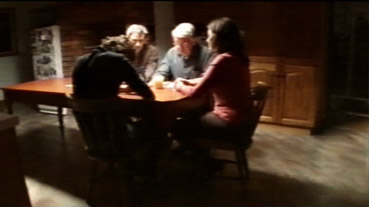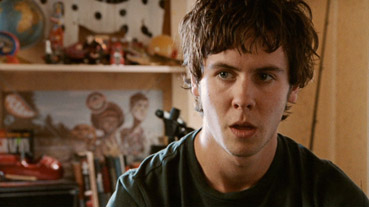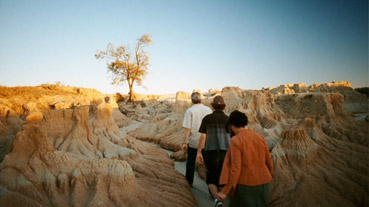|
There's an interesting disparity to the manner in which lakes are perceived in life and in films. In the real world lakes are generally seen in a positive light, as serene locations for relaxation and appreciation of the beauty of nature. The very idea of spending few days at a lakeside property is close to idyllic. But in movies lakes are almost always bad news. Lake Placid had an oversized man-eating alligator, Eden Lake had murderous kids, and I won't even start on Blood Lake, Ghost Lake and Blue Lake Massacre. Suffice to say, if the movie has the word Lake in the title, then there's probably going to be trouble.
So a title like Lake Mungo should fill us with dread, and it probably would do were it not for that second word. For an English audience of a certain age – my age, as it happens – the word Mungo is more likely to recall bouncy 70s rock band Mungo Jerry or 60s children's television series Mary, Mungo and Midge. A little research reveales that Mungo is the name of an ethnic group in Cameroon, an oil field in the North Sea, and that Saint Mungo (who also known as Kentigern) is the patron saint of Glasgow. And guess what, there really is a Lake Mungo, located in New South Wales in Australia, the very country in which the said titled film was made.

Lake Mungo is a drama-documentary in the mould of Stefan Avalos and Lance Weiler's The Last Broadcast, a too little seen faux-documentary horror work that predated the similarly themed The Blair Witch Project by almost a year. The focus of the film is the Palmer family, whose daughter Alice drowns on a family picnic, a death they all have considerable trouble coming to terms with. A short while after the funeral, their house becomes host to inexplicable noises, and when son Matthew inadvertently captures Alice's image in a photograph, they begin to suspect that she may not be at rest.
Right from the start, first-time feature director Joel Anderson creates an almost watertight sense that we're watching a documentary rather than a constructed fiction. The interviewees are all convincingly naturalistic and the news reports look authentic, right down to the graphics and the degraded quality of the video. For the most part, the film plays like a TV special, telling its story in retrospect with the traditional blend of interviews, news reports, archive footage, stills and home videos, interspersed by the sort of slow camera drifts through empty rooms that would not be out of place in an Errol Morris film. Even the music is employed in the manner of a current affairs documentary, emphasising unsettling discoveries and underscoring mood rather than accelerating action or delivering shocks.
It certainly looks and sounds the part, but how does it play out? Well therein lies the film's strengths and weaknesses, and the chances are we'll disagree about the quantity and even existence of both. It's worth noting up front that Lake Mungo was never designed to scare its audience shitless. At least I presume it wasn't. Its approach is more gentle than the likes of Paranormal Activity and more focussed on the recollections and reactions of Alice's family than the supernatural elements. Indeed, there's an argument for suggesting that this is not a horror film at all but a study of the process of grieving and adjustment to loss. In this respect the film is quietly effective, with even a neat mid-film twist driven very much by the family's attempts to come to terms with Alice's death.

The problem for the film, at least in modern horror terms, is that the departed Alice's sole party trick is to appear in the background of photographs and video recordings, a familiar concept which is traditionally the kicking off point for an escalation of supernatural activity that simply never occurs here. It all builds nicely to the aforementioned mid-film twist, but instead of taking the haunting in a new direction, it delivers more of the same, presumably on the basis that we'll be disturbed by the the realisation that what we thought was fake may be real after all. Even the final revelation about just what took place at the title location, which unfolds with the aid of eerily indistinct mobile phone footage, plays out as an unsettling and inexplicable event in a geographically strange location rather than the big revelation of a Laura Palmer-esque secret we've been led to expect.
I'll openly admit this is a personal reaction from someone who admired but was not in anyway rattled by either The Blair Witch Project or the first Paranormal Activity (though for some reason the second one really got under my skin), and that others claim to have been seriously creeped out by writer-director Joel Anderson's film. It's strength lies in its portrait of a family coming to terms with the death of a loved one, but by telling that story through retrospective interview, the film temporally distances us from the event itself and the devastating emotional impact we can only presume it had. We're left with an involving and well executed curio, one that succeeds as drama and as a technical exercise in faux-documentary, but whose determinedly low key realism and recollective approach ultimately mute both its horror and emotional impact.
According to the filmmakers, Lake Mungo was shot on over forty different cameras using a variety of media, including 35mm and Super-16 film, HD, Digi-beta, Hi8, Super 8, VHS and mobile phones, some of which was treated or copied to produced the desired visual effect.* The quality of the resulting 1.78:1 anamorphic transfer is thus be only accurately judged by the best of this material, which is consistently good, boasting naturalistic colours, a very reasonable sharpness, a punchy contrast range, and solid black levels, even at night. Obviously the quality drops markedly when the image switches to VHS, Hi-8 or mobile phone footage, but this is both deliberate and appropriate, give that it is designed to be recognised as low-band material.

There's a choice between Dolby 2.0 stereo and Dolby 5.1 surround soundtracks, and with the film this gentle in its technical handling it's all about where you want the dialogue to sit (in the centre on 5.1, spread right across the front sound stage on stereo), the volume and spread of the ambient sound (unsurprisingly, it's louder on 5.1), and the pitch and range of vocal reproduction, which is fuller and displaying a touch more more bass on the surround track. The music is almost identical on both tracks.
There's always a dichotomy facing distributors of drama-documentaries that set themselves up as the real deal, as many of the traditional extra features, particularly commentaries and interviews, would require those involved to tell a few creative porkies if the illusion is to be maintained.** Thus many such films make their first DVD appearance with little in the way of backup material, save for a trailer and, just occasionally, a fake featurette designed to give professional or anecdotal credence to the authenticity of the main feature. In the case of Lake Mungo, UK distributor Second Sight have elected to stick with the main feature only. So apologies for the misleading length of this paragraph, but there's not a thing here.
A captivatingly told, intriguingly structured and very well made mystery thriller in a faux-documentary mould. It's restraint and subtlety are admirable, and as an emotionally detached study of a family coping with loss it's disarmingly convincing. But as a mystery thriller it's happy to be quietly creepy where it should have been scary, and its final revelation doesn't deliver what I can only presume was the desired impact. I'm fully aware that my complaints are as much a reflection of my own views on the supernatural as they are on the film – I find the very idea of ghosts quite preposterous, and was faking the sort of photographs that the film presents as evidence for years before Photoshop made it a two-minute job. But it clearly works for some and even for us cynics is definitely worth a look, particularly as the inevitable and doubtless overblown Hollywood remake is already in the works.
|